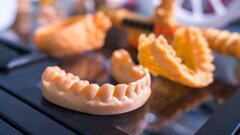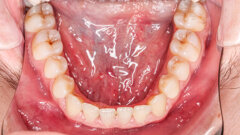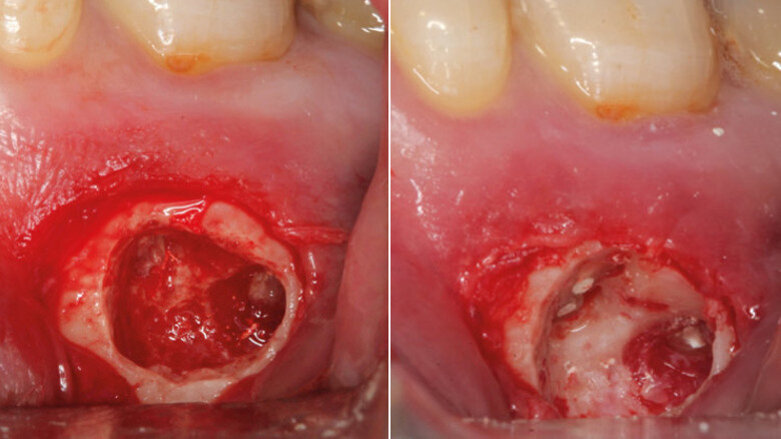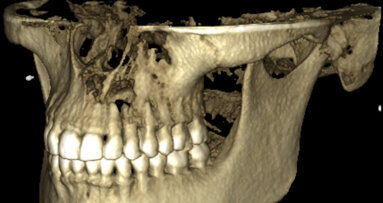The aim of the current investigation was to review techniques and materials available to achieve bleeding control during periapical surgery. An adequate bleeding control is crucial, since it improves vision in the surgical site, minimizes surgical time, enhances the root-end resection and filling, and reduces surgical blood loss, postsurgical hemorrhage and postsurgical swelling.
Methods: An update is made of the aspects to be considered during bleeding control in periapical surgery.
Results: The hemostatic agents that have been proposed in the literature have characteristics that make them very different from each other, such as the mechanism of action, commercial presentation, hemostatic efficacy and systemic effects.
Conclusion: The hemostatic agents that have obtained the best results are ferric sulfate, calcium sulfate, aluminum chloride and epinephrine. Nevertheless, there is no consensus in the literature on which is the ideal hemostatic agent.
Editorial note: The full article was published in the 3/2018 issue of the Journal of Oral Science and Rehabilitation. It can be accessed free of charge at www.dtscience.com.
Interview with Isabel Menéndez Nieto
Ms. Menéndez Nieto, why did you conduct the research reported on in this paper?
It is intended to provide an update of all the clinical and biological aspects to be considered during bleeding control in periapical surgery.
For what reasons could others cite your paper?
The ability to achieve tissue hemostasis in the surgical site is crucial to the performance of periapical surgery; nevertheless, the number of publications on this field is very scarce.
How could your study’s findings have an impact on dentistry?
This article updates professionals from a scientific and clinical perspective, since some of the most relevant aspects of hemostatic agents are detailed: mechanism of action, commercial presentation, techniques for application, hemostatic efficacy and adverse effects.
What is the relevance of your study’s findings to the daily practice of a dentist?
This paper is written as a guideline for clinicians. The characteristics and the results reported in the literature of the various hemostatic agents proposed for the control of hemorrhage in periapical surgery are detailed.
What are your recommendations for further investigation of the topic of your article?
Further studies with a randomized controlled design are needed to improve knowledge about bleeding control. Studies should be designed to analyze the influence of hemostatic materials used on the long-term prognosis.
Tags:
An update is made of the aspects to be taken into account during flap detachment and retraction in periapical surgery as one of the key elements for ...
AARHUS, Denmark: As the implementation of artificial intelligence (AI) in the dental industry continues to accelerate, there appears to be a growing ...
NEW YORK, USA: When completing the restoration of a single-tooth implant in the esthetic zone, many dentists may find it challenging to choose the ...
In 1986 Mauro Labanca earned his Medical Doctor degree from the University of Milan, where he also qualified in dentistry and general surgery. He has ...
VIENNA, Austria: At EuroPerio11, which will be held from 14 to 17 May, a dedicated session will shine a spotlight on patients’ involvement in their ...
As dental support organisations (DSOs) continue to grow in presence and scale, many dentists are asking an important question: is it possible to preserve ...
If there is one thing that dentistry has taught me, it is that the ability to read people will take a clinician further than any continuing education course...
BASEL, Switzerland: BioHorizons Camlog has announced that it will be participating in the joint meeting of the European Association for Osseointegration ...
LEIPZIG, Germany: Although oral health is increasingly recognised as a cornerstone of overall health, significant disparities in access to care and ...
WASHINGTON, US: The American Academy of Facial Plastic and Reconstructive Surgery (AAFPRS) has recently released the results of its 2024 annual member ...
Live webinar
Mon. 12 January 2026
9:00 am EST (New York)
Prof. Judith Jones D.D.S; M.P.H., Prof. Kakuhiro Fukai D.D.S., Ph.D, Dr. Bathsheba (Bethy) Turton
Live webinar
Wed. 14 January 2026
12:00 pm EST (New York)
Dr. Théo Laplane, Dr. Robert Gottlander DDS
Live webinar
Fri. 16 January 2026
12:00 pm EST (New York)
Live webinar
Mon. 19 January 2026
1:00 pm EST (New York)
Philipp Kopp, Michael Seeber
Live webinar
Thu. 22 January 2026
2:00 pm EST (New York)
Dr. Nicola M. Grande DDS, PhD
Live webinar
Wed. 28 January 2026
8:00 am EST (New York)
Live webinar
Wed. 28 January 2026
11:00 am EST (New York)
Prof. Dr. Jan-Frederik Güth



 Austria / Österreich
Austria / Österreich
 Bosnia and Herzegovina / Босна и Херцеговина
Bosnia and Herzegovina / Босна и Херцеговина
 Bulgaria / България
Bulgaria / България
 Croatia / Hrvatska
Croatia / Hrvatska
 Czech Republic & Slovakia / Česká republika & Slovensko
Czech Republic & Slovakia / Česká republika & Slovensko
 France / France
France / France
 Germany / Deutschland
Germany / Deutschland
 Greece / ΕΛΛΑΔΑ
Greece / ΕΛΛΑΔΑ
 Hungary / Hungary
Hungary / Hungary
 Italy / Italia
Italy / Italia
 Netherlands / Nederland
Netherlands / Nederland
 Nordic / Nordic
Nordic / Nordic
 Poland / Polska
Poland / Polska
 Portugal / Portugal
Portugal / Portugal
 Romania & Moldova / România & Moldova
Romania & Moldova / România & Moldova
 Slovenia / Slovenija
Slovenia / Slovenija
 Serbia & Montenegro / Србија и Црна Гора
Serbia & Montenegro / Србија и Црна Гора
 Spain / España
Spain / España
 Switzerland / Schweiz
Switzerland / Schweiz
 Turkey / Türkiye
Turkey / Türkiye
 UK & Ireland / UK & Ireland
UK & Ireland / UK & Ireland
 Brazil / Brasil
Brazil / Brasil
 Canada / Canada
Canada / Canada
 Latin America / Latinoamérica
Latin America / Latinoamérica
 USA / USA
USA / USA
 China / 中国
China / 中国
 India / भारत गणराज्य
India / भारत गणराज्य
 Pakistan / Pākistān
Pakistan / Pākistān
 Vietnam / Việt Nam
Vietnam / Việt Nam
 ASEAN / ASEAN
ASEAN / ASEAN
 Israel / מְדִינַת יִשְׂרָאֵל
Israel / מְדִינַת יִשְׂרָאֵל
 Algeria, Morocco & Tunisia / الجزائر والمغرب وتونس
Algeria, Morocco & Tunisia / الجزائر والمغرب وتونس
 Middle East / Middle East
Middle East / Middle East















































